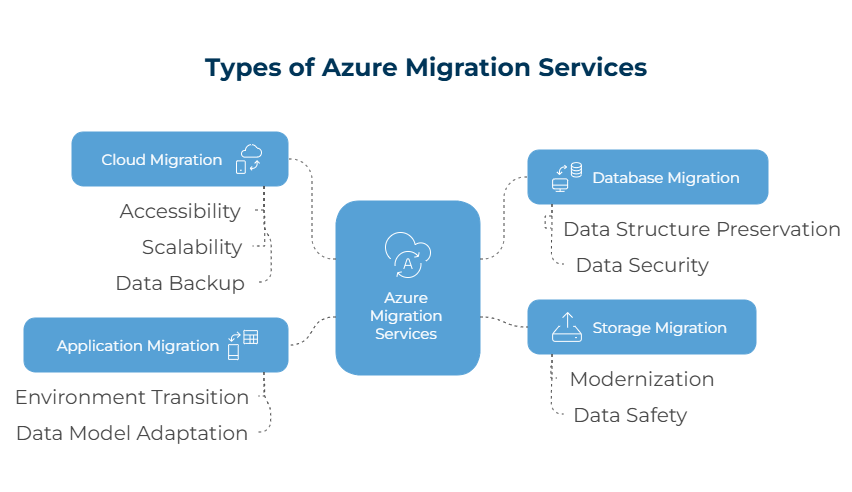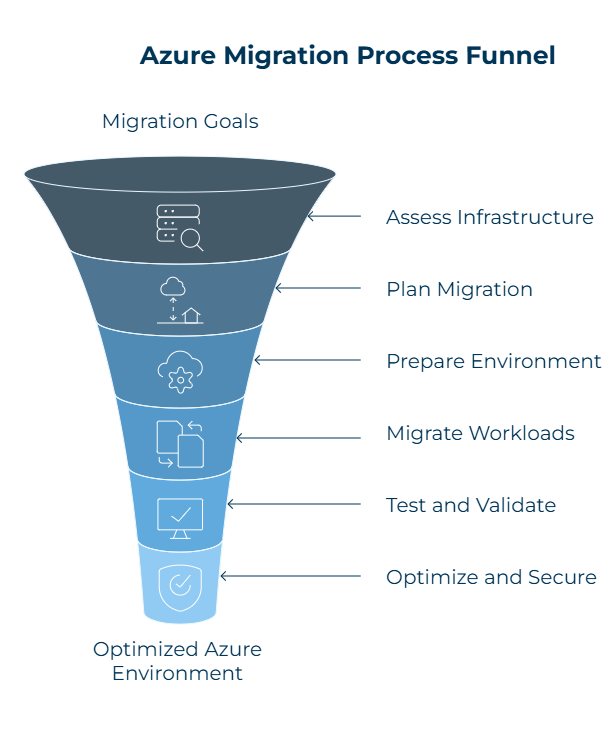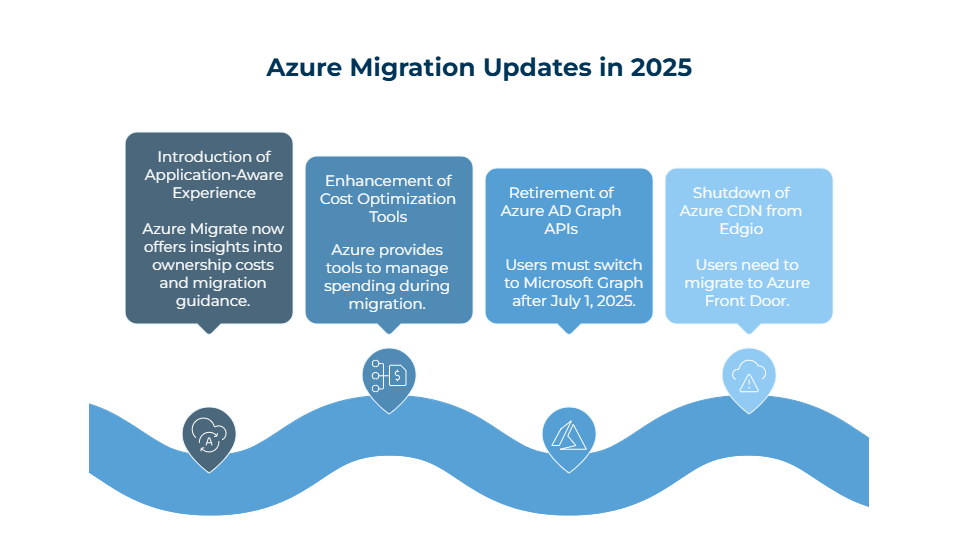What Is Azure Migration and Why Does Your Business Need It In 2025?

Azure migration has become one of the go-to moves for businesses and organizations who aim to enhance flexibility, scalability and cost-efficiency.
As we all step into 2025, Microsoft continues to introduce the latest updates and features to assist businesses with simplifying their migration process as well as the post-migration performance.
This blog will highlight more details on Azure migration, what is it, why is it important and so much more.
What is Azure Migration?
Azure migration can be defined as the complete process of transferring a business’s applications, workloads, and data from a traditional on-premises setting to other cloud platforms or other MS environments.
A cloud migration process involves a chain of carefully planned steps to get an efficient and seamless transition.
The process starts with a careful assessment where businesses assess their existing IT landscape and identify the resources and apps that can be migrated.
Table of Contents
Azure Migration Trends

Azure cloud migration is going to prevail in 2025. There are many organizations who are still in the process of moving to the cloud and the speed is the same as it was in 2024.
According to a report by Gartner, over 70% of the companies have some sort of cloud footprints, and more than 80% of them are about to adopt a cloud-first approach in 2025.
How Does the Migration Process work?
The process includes detailed planning, where companies devise a migration strategy aligning with your business goals considering factors such as performance, security, and costs.
Eventually, the execution phase includes the effective transfer of applications and data to Azure. It uses advanced tools and technologies to cut down disruptions and downtime. Tools such as Azure Migrate play a critical role in this process.
It allows businesses to discover and assess their on-premises resources centrally. Let us further break down this technology.
Accelerate Growth with Azure Cloud Solutions
What is Azure Migrate?
On-premises setups have become a thing of the past while cloud migration is prevailing in the global economy. Among these Azure Migrate has become one of the most sought-after services in the market.
It is a Microsoft service which assists in planning a cloud migration. It doesn’t shift the on-premises VMs (Virtual Machines) to the cloud. For that matter, the cloud service provider encourages using Azure Database Migration services, or Azure Site Recovery.
Organizations and enterprises optimize this technology to collect data on Hyper-V and VMware. This may include extracting information from performance history, memory usage, and data.
It can also perform dependency checking as a part of the discovery process to assist a business visualize resource dependencies of an individual VM or a bunch of VMs.
In order to get started, a business needs to create an Azure Migrate project within the Azure portal. It then opens a Virtual Appliance (.ova file) and imports under the name collector appliance.
What are Azure Migration Services?
These services use Azure Migrate to help businesses assess, scale, and migrate public and private cloud workloads to Azure.
It ensures a centralized hub to evaluate Linux and Windows virtual and physical servers, web apps, and databases and migrate them to Azure.
There are two key tools in Azure Migrate:
- Server Migration: It optimizes a replication appliance to agent-based VMware VMs, public cloud VMs, and physical servers to Azure.
- Discovery and Assessment: It uses lightweight appliance software which could run on-premises to collect and transfer the data needed to Azure.
Azure Migrate allows companies to access insights into their existing infrastructure, plan the process with precision, as well as execute it effectively.
Therefore, ensuring that this is all done without any disruptions to the company’s continuity and operations.
Apart from facilitating a seamless transition, it enables organizations to leverage its complete capabilities of flexible and scalable cloud services.
What are the Benefits of Azure Migration?
Azure Migration provides various benefits to the organization. From cost efficiency to innovation, it offers tremendous perks to a company.
- Cost Efficiency: With Azure’s pricing models like reserved instances and pay-as-you-go, businesses can refine their spending and cut overall IT costs.
The best part is, if you use its services long-term, you can get attractive discounts. Thus, again allowing you to cut unnecessary costs and manage your IT budget effectively. - Scalability and Flexibility: Microsoft Azure offers a range of services and capabilities that can help your business scale up and down depending upon what you need. It makes sure that you only pay for the necessary features.
Therefore, allowing the right amount of power to you without having to overpay or underperform. Whether you are operating a massive system or a small app, Azure adapts as your business scales. - Better Security: Azure has built-in security at its core. It optimizes advanced tools to manage access and safeguard your data from minor threats.
No matter if you are managing; business apps or handling customer data, Azure offers robust and reliable protection. - Enhanced Performance: With the global network of data centers of Azure, businesses can get low-latency access to their data and apps while enhancing their overall performance.
- Innovation: Azure offers a suite of extensive services which includes machine learning, Artificial intelligence and analytics which allows companies to stay competitive with their innovations in their industries.
With this, you can explore new ideas, get deeper insights, and build smarter solutions. No matter what your goal is; launching a new product or improving decision-making, you can still stay ahead in this dynamic economy.
Your Cloud Journey Starts with Azure
What are the Types of Azure Migration Services?

There are different types of Azure migration services and some of them include:
- Database Migration: Database migration refers to moving data from one database system to another one. The best part about it is that the data structure does not change. Therefore, leading to no major changes in how the data is used or organized.
The process also makes sure that your data remains secure while transitioning it without facing any damages or losses. - Storage Migration: Storage migration means transferring data from one storage to another such as moving files from old hard drives to a new one across cloud providers.
It also helps in upgrading to safer, faster and way more modern storage systems. Azure storage migration services ensure that your data is safe and ready to use with no risks. - Application Migration: You can opt for this migration when a company has to move an app from one environment to another environment such as switching from a conventional set to a cloud-based platform.
To make sure the app and its data can function correctly in the new system, a unique data model is employed during this process. Making sure everything fits and functions the same in a new home is similar to packing up your old one. - Cloud Migration: Cloud migration can be explained as transferring your apps, data and other digital assets to the cloud such as Microsoft Azure.
It serves massive benefits where you do not require big servers to access your data. You can do it from anywhere. The most interesting part is that it is cheaper and easier to scale your business with this. Moreover, cloud providers deliver strong data backup and recovery which helps protect against data loss.
For best results, you must find the right Azure migration consulting services
What are the Steps of the Azure Migration Process?

As already discussed, Azure migration is the process that modernizes your IT infrastructure, minimizes costs, boosts performance, and enhances scalability. However, an efficient migration needs a lot more than just moving data. It needs:
- Define Strategy and goals.: The first step is to define your purpose. Why are you moving to Azure? Are you planning to reduce hardware costs, enhance application performance, or boost security? Setting clear goals ensures that your migration coordinates with your business needs.
- Assess Current Infrastructure: In the next step, you assess your existing infrastructure which may include navigating all servers, databases, applications, and storage systems. Microsoft Azure Migrate tools allow you to gather detailed information about your workload to evaluate its readiness and estimate the cost for the same.
- Plan and design migration: Once you understand how your current setup is, you can then plan on how to move it to Azure. This may involve choosing suitable Azure services, deciding on a migration approach, and preparing a timeline. You also design cloud architecture such as security, networking, and compliance requirements.
- Prepare the Azure Environment: Before starting the actual migration, you must set up the Azure environment to receive your workloads. This may include creating resource groups, configuring virtual networks, setting up identity and access controls, and ensuring security and governance policies are intact.
- Migrate Workloads: In this step, you start moving applications, data, and infrastructure to Azure. It is up to you whether you wish to migrate data all at once or in pieces. You can use tools such as Database Migration Service, Azure Site Recovery, and Azure Migrate to help manage and automate the migration process efficiently.
- Test and Validate: Testing becomes vital as soon as you transfer your workload in Azure. You need to check whether everything works fine. Applications are working, data is intact, and the performance is as expected. This phase is essential to ensure users face minimal disruptions.
- Optimize and Secure: After migration is done, you can make necessary adjustments to your Azure environment. This may include resizing resources. Turning unused services off and boosting security using tools like Microsoft Defender for Cloud and Azure Security Center.
What are the Latest Updates on Azure Migration?

Azure has rolled out various important updates in 2025 to streamline the migration process and boost user experience. Given below are further details:
- One of the updates is the introduction of an application-aware experience in Azure Migrate.
- It enables businesses to get insights into the total ownership costs, receive customized migration, find suitable PaaS and IaaS, and modernization guidance.
- In addition to this, Azure has boosted its cost optimization tools. Thus, allowing businesses to manage their spending effectively during the migration period.
- The retirement of Azure AD Graph APIs is one of the most critical updates.
- After July 1, 2025, everyone who uses the old version will have to switch to Microsoft Graph.
- The old system, Azure CDN from Edgio is shutting down and the .NET installers will need to move to Azure Front Door.
Those who are hoping to expand, cut expenses, and maintain their competitiveness in the rapidly evolving digital landscape of today would be wise to migrate to Azure.
Whether you’re transferring your data, apps, or storage to the cloud, Microsoft Azure provides the resources and assistance you need to ensure a safe and easy transition.
Businesses can improve planning, prevent downtime, and ensure flawless operation in the new environment with the help of robust Azure services.
Azure also lets you get more out of your IT systems with features like high performance, robust security, and cost optimization.
If you are looking for the best Azure migration services or need a consultation, you can visit us here
Frequently Asked Questions
Q1. What is Azure Migration?
Azure migration refers to the process of moving apps, data, and workloads from an on-premises setting to Microsoft 365 or Microsoft Azure or another cloud platform.
Q2. What are Cloud Migration Services?
These services assist businesses in moving their apps, data and IT infrastructure from a cloud provider or an on-premises setup to a cloud environment such as Azure. Typically, it aims at boosting performance, cutting costs, and enhancing scalability.
Q3. What is Azure Migrate?
Azure Migrate is a service that allows businesses to plan, decide, and execute their migration to Azure.
Q4. Where do you Store Azure migrate data?
Azure Migrate appliance collects data and stores it where the user created a project.



